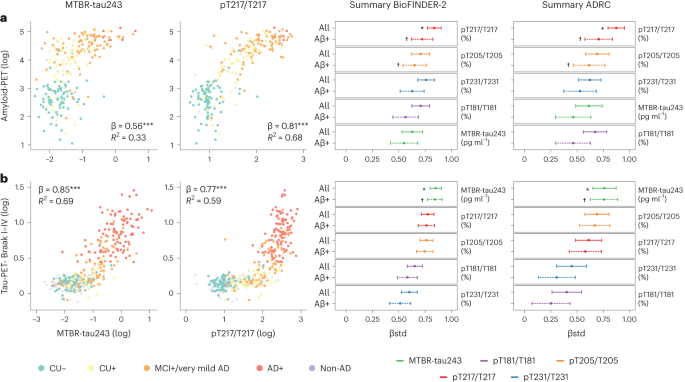脳脊髄液から発見された新しいマーカーはアルツハイマー病治療薬の開発を早める可能性もある Novel marker found in cerebrospinal fluid also could speed development of Alzheimer’s drugs
2023-07-13 ワシントン大学セントルイス校
◆この研究により、アルツハイマー病の診断と進行の段階をより正確に把握する方法が進展し、臨床試験の参加者の特定とモニタリング、および治療薬の開発が迅速化される可能性があります。また、この研究により、アルツハイマー病のタウタンパク質による病態進行を抑える治療法の開発にも一歩近づきました。
<関連情報>
- https://source.wustl.edu/2023/07/tau-based-biomarker-tracks-alzheimers-progression/
- https://www.nature.com/articles/s41591-023-02443-z
CSFのMTBR-tau243はアルツハイマー病におけるタウ絡み病態の特異的バイオマーカーである CSF MTBR-tau243 is a specific biomarker of tau tangle pathology in Alzheimer’s disease
Kanta Horie,Gemma Salvadó,Nicolas R. Barthélemy,Shorena Janelidze,Yan Li,Yingxin He,Benjamin Saef,Charles D. Chen,Hong Jiang,Olof Strandberg,Alexa Pichet Binette,Sebastian Palmqvist,Chihiro Sato,Pallavi Sachdev,Akihiko Koyama,Brian A. Gordon,Tammie L. S. Benzinger,David M. Holtzman,John C. Morris,Niklas Mattsson-Carlgren,Erik Stomrud,Rik Ossenkoppele,Suzanne E. Schindler,Oskar Hansson & Randall J. Bateman
Nature Medicine Published:13 July 2023
DOI:https://doi.org/10.1038/s41591-023-02443-z

Abstract
Aggregated insoluble tau is one of two defining features of Alzheimer’s disease. Because clinical symptoms are strongly correlated with tau aggregates, drug development and clinical diagnosis need cost-effective and accessible specific fluid biomarkers of tau aggregates; however, recent studies suggest that the fluid biomarkers currently available cannot specifically track tau aggregates. We show that the microtubule-binding region (MTBR) of tau containing the residue 243 (MTBR-tau243) is a new cerebrospinal fluid (CSF) biomarker specific for insoluble tau aggregates and compared it to multiple other phosphorylated tau measures (p-tau181, p-tau205, p-tau217 and p-tau231) in two independent cohorts (BioFINDER-2, n = 448; and Knight Alzheimer Disease Research Center, n = 219). MTBR-tau243 was most strongly associated with tau-positron emission tomography (PET) and cognition, whereas showing the lowest association with amyloid-PET. In combination with p-tau205, MTBR-tau243 explained most of the total variance in tau-PET burden (0.58 ≤ R2 ≤ 0.75) and the performance in predicting cognitive measures (0.34 ≤ R2 ≤ 0.48) approached that of tau-PET (0.44 ≤ R2 ≤ 0.52). MTBR-tau243 levels longitudinally increased with insoluble tau aggregates, unlike CSF p-tau species. CSF MTBR-tau243 is a specific biomarker of tau aggregate pathology, which may be utilized in interventional trials and in the diagnosis of patients. Based on these findings, we propose to revise the A/T/(N) criteria to include MTBR-tau243 as representing insoluble tau aggregates (‘T’).


